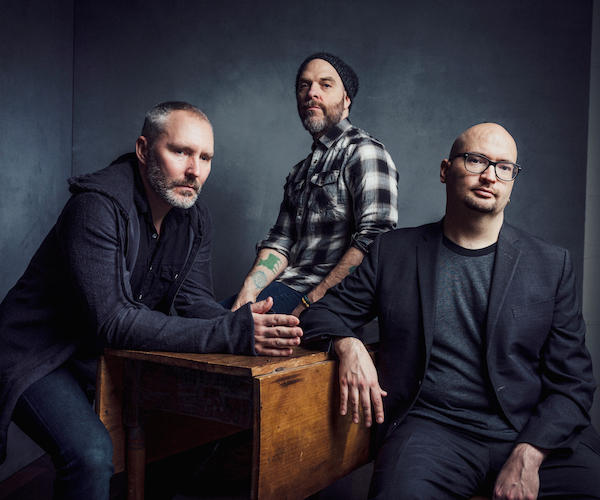Jazz Concert Review: The Bad Plus — Say again?
You could sometimes be halfway into a Bad Plus show before hearing anything like a jazz chord from pianist Ethan Iverson.
The Bad Plus Presented by World Music/CRASHarts at Berklee Performance Center, Boston, MA, on November 12

The Bad Plus — a change in personnel is coming. Photo: Josh Goleman.
By Jon Garelick
The Bad Plus emerged from the Minneapolis scene 17 years ago and almost immediately began turning the whole idea of the acoustic-jazz piano trio upside down. It wasn’t just the oddball covers – Black Sabbath’s “Iron Man,” Nirvana’s “Smells Like Teen Spirit,” Blondie’s “Heart of Glass.” It was the whole deal. The originals they wrote seemed more closely related to those covers than to jazz – pieces like “Dirty Blonde” (by Bad Plus bassist Reid Anderson) reveled in a kind of melodic/orchestral bombast that was very unjazz. And yet, Anderson’s pliant, rich acoustic bass and drummer David King’s precise maneuvers in and around the beat – who else but jazz musicians would play like this? But the overall effect was the nearest thing to prog-rock you’d ever hear from a keyboard jazz trio this side of Emerson Lake and Palmer (the Bad Plus did release an album called Prog, after all, which included Bowie and Bacharach, but no ELP). You could sometimes be halfway into a Bad Plus show before hearing anything like a jazz chord from pianist Ethan Iverson.
The Bad Plus are now on what amounts to a farewell tour for Iverson, having announced that he’ll be leaving the band and, as of January 1, be replaced by Orrin Evans. At Berklee Peformance Center in Boston on November 12, in a concert presented by World Music, they remained by turns as perplexing and compelling as they’ve always been. There was the mix of bombast and rigorous attention to detail, the precisely calibrated expanding and contracting arrangements. There were not a lot of solos per se, although there were featured passages for each instrument. One of their standard bits is for King’s drums to play the melodic rhythm of, say, a tune like Cyndi Lauper’s “Time After Time” along with Iverson. And they loved one little bit on that tune in particular – the fast phrasing of the lead-in to the hook (“If you’re lost, you can look and you will find me”), like a little bugle-call from Iverson’s right hand.
Pop covers like this aren’t necessarily “deconstructions” — even with Iverson’s moody chords in the Lauper: that and the encore of “Heart of Glass” were immediately recognizable. The Bad Plus touch comes in the arrangements, in the playing with tempo, the little accelerandos and decelerandos from phrase to phrase. What they do isn’t exactly the jazz version of theme and variation – “playing the changes.” Rather, they work a tune over. Sometimes it seems that everything has become a kind of passacaglia – Iverson playing the tune over and over while King propels a free-jazz-rock clatter, always lucidly transparent no matter how busy, and Anderson patiently holds steady and outlines the harmonies.
There was much to admire in the show — the attention to detail was remarkable throughout, the independence in Iverson’s voicings, the repetition of slow melody in right hand with free-flowing chromatic scales in the left (Barry Manilow’s “Mandy”), the on-a-dime dynamic shifts (no one chokes a cymbal with more delicate strength than King), the odd compositional structures with unpredictable “middle” sections.
But even while admiring the imagination and execution, I’m sometimes left cold by some of the band’s proggier conceptions. (Anderson’s “Dirty Blonde” is an early “hit,” but maybe a bit much of a grand edifice for me.) So Ornette Coleman’s “Law Years” can be a relief, with fast-walking bass and drums and a bass/brushes duet that couldn’t be topped. And “Mandy” turned positively grunge, getting louder and louder, with Iverson, standing, holding down the sustain pedal and pounding the bass register with his fist. Iverson’s “County Seat” coaxed the requisite jazz-fan “woo!” out of me, as the pianist ran extended lines through bluesy cadences.
Anderson called that one a “niche” selection from “jazz songs about municipal bureaucracy.” That dry humor doesn’t hurt either. Anderson introduced “Mandy” as Barry Manilow’s first hit and pointed out that it was released in 1973, the same year as “Law Years” — which he said, “just goes to show how big the universe is.” That seemed to be their point also. Not just, as Coleman said, This Is Our Music, but as they said on their own Columbia debut, These Are the Vistas. Serious, wiseass, and generous – not bad things for any performer to be. (And you know that, brilliant as some performers may be, they’re not always generous.)
The show also had moments of quiet beauty – as on Anderson’s ballad-tempo “Neptune,” when Iverson’s right hand went off into a little rhapsody while his left hand repeated the melody, the piece ending with a soft rattle from King and a split-second atonal string-scrape by Anderson. It reminded me of seeing the band when they were touring as a quintet last year, playing Coleman’s “Science Fiction” – a bit in which Iverson and cornettist Ron Miles broke off from the group for a brief duet, like some impromptu sonata, formal but free, a moment of suspended time, mysterious and wonderful. Like jazz.
Jon Garelick is a member of The Boston Globe editorial board. A former arts editor at the Boston Phoenix, he writes frequently about jazz for the Globe, The Arts Fuse, and other publications.
